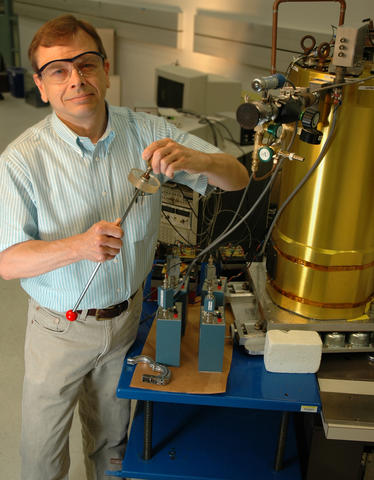
Research physicist Terrence Jach prepares to analyze a sample with the NIST X-ray microcalorimeter. Improved temperature sensing and control systems allow the instrument within the gold chamber to the right to detect X-rays characteristic of specific elements over a broad range of energies with higher resolution.
Researchers at the National Institute of Standards and Technology (NIST) have developed an improved experimental X-ray detector that could pave the way to a new generation of wide-range, high-resolution trace chemical analysis instruments. In a recently published technical paper*, the researchers described how they used improved temperature-sensing and control systems to detect X-rays across a very broad range of energies (6 keV or more), with pinpoint energy resolution (an uncertainty of only 2 eV).
The detector’s ability to distinguish between X-rays with very similar energies should be especially useful to the semiconductor industry for chemical analysis of microscopic circuit features or contaminants. Many types of high-resolution microscopes routinely used in the industry and throughout science produce detailed chemical maps by scanning a surface with electrons and then analyzing the X-rays emitted, which are characteristic of specific elements.
The NIST device, an improved version of its previous microcalorimeter X-ray detector, uses a quantum-level, transition edge sensor (TES). NIST has led development of these sensors for several years. A TES works by measuring the current across a thin metal film that is held just at the knife-edge transition temperature between a superconducting state and normal conductance. A single X-ray photon striking the detector raises the temperature enough to alter the current proportional to the energy of the photon.
TES microcalorimeters offer an unequaled combination of high resolution with detection of a broad energy range, allowing identification of many different chemical elements simultaneously. The two kinds of detectors conventionally used in X-ray microanalysis typically have a resolution of no better than 130 eV, or have a high resolution but only for a very narrow range of energies. TES sensors, however, must be kept at very low temperatures (about 97 millikelvin) for hours at a stretch to collect trace-level data. Tiny changes in temperature would cause previous versions of the instrument to “drift” over time, requiring constant recalibrations. The improved temperature control system for the new detector eliminates this problem, making the system much more practical for a broad range of applications.
*T. Jach, J.A. Small and D.E. Newbury. Improving energy stability in the National Institute of Standards and Technology microcalorimeter X-ray detector. Powder Diffraction v. 20, No. 2, June 2005.

